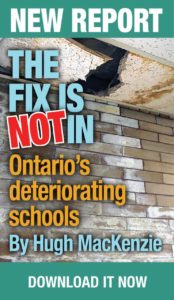Fund the repair of Ontario’s crumbling schools
 Submissions to the Ministry of Education on what we need to see in the 2018 Grants for Student Needs (GSNs) have been coming in from across the province. Here is CPE’s submission.
Submissions to the Ministry of Education on what we need to see in the 2018 Grants for Student Needs (GSNs) have been coming in from across the province. Here is CPE’s submission.
Based on the Ministry’s own figures, senior economist Hugh Mackenzie, in his new report, Ontario’s Deteriorating Schools; The Fix is Not In, concludes that $1.6 billion of additional funding will be needed each year to truly fix Ontario’s schools.
This submission is being sent to the Ministry in the hope that the 2018 GSNs will address the actual funding needed to eliminate the $15.9 billion school repairs and maintenance backlog in order to fully fix Ontario schools.
In light of Mackenzie’s findings, we’d like you to seriously consider including the following six funding requirements in the 2018 GSNs.
- Keep the special School Condition Improvement (SCI) funding at $1 billion per year until the repair backlog is gone, in conjunction with the following funding steps.
- Increase annual School Renewal Allocation (SRA) funding from the current $357 million per year to $1.7 billion per year,and maintain that funding at 3% of the replacement value of Ontario’s schools to conform to generally accepted level of renewal funding required to keep schools in a state of good repair.
- Create a new and separate capital stream of funding to rebuild the 346 school buildingsacross the province determined to be too expensive to repair as of the most recent provincial review cycle; estimated $3.9 billion one-time capital injection amortized over 40 years would result in a new budgetary expense of $100 million per year.
- Increase the current operational maintenancebudget by $165 million per year (an 8.7% increase from current levels, based on industry averages) and ensure that the formula used to determine this annual figure explicitly recognizes the underlying drivers of differences in operating costs for schools in the province including: labour costs in the community, heating costs and climate, age & design of school buildings.
- Approach school closuresnot via the lens of utilization but by determining if the school is a key element of a community and by taking into account the implications for student access to programs and commute times. If it is decided that the school should remain open, then school capital costs and operational maintenance costs must be fully funded, regardless of the utilization of that school.
- Establish a commonly understood and measurable standard of good repairmust be developed and implemented for Ontario schools, (taking into consideration not only Ontario’s FCI data but also things such as water quality, air quality and temperature of classrooms. These standards should be applied not only to permanent school buildings but also to portables, which often end up being on a school site for over a decade).
Of course this is a considerable amount of new money to be asking for in the provincial education budget. However, note that the $1.6 billion increase over current total funding levels drops to $1 billion once the backlog is gone.
As you are well aware, schools are a critical element of our public infrastructure. There are 2 million Ontario children who spend their days in school buildings and need safe, healthy, well maintained places to learn. Teachers, education workers, adult learners, and pre-schoolers who attend childcare facilities in local public schools also need safe, healthy, well-maintained environments in which to work and learn.
Obviously repairs to Ontario’s schools are only going to get more expensive if we do not fully address the $15.9 billion repair backlog as soon as possible.



